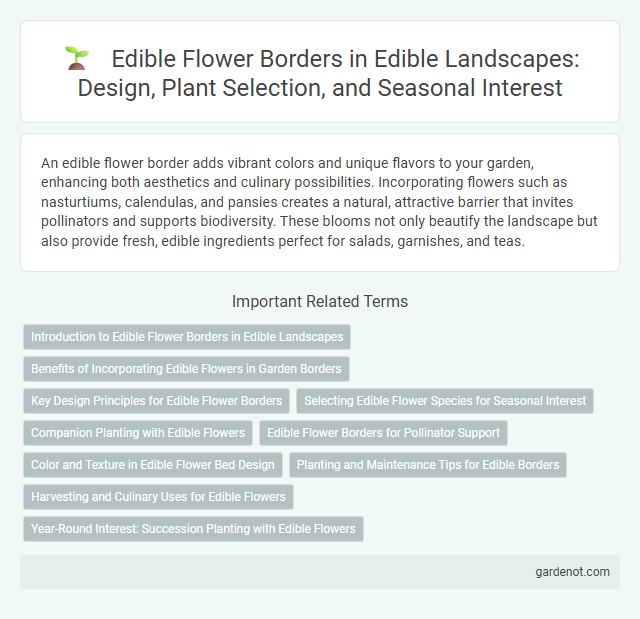An edible flower border adds vibrant colors and unique flavors to your garden, enhancing both aesthetics and culinary possibilities. Incorporating flowers such as nasturtiums, calendulas, and pansies creates a natural, attractive barrier that invites pollinators and supports biodiversity. These blooms not only beautify the landscape but also provide fresh, edible ingredients perfect for salads, garnishes, and teas.
Introduction to Edible Flower Borders in Edible Landscapes
Edible flower borders enhance edible landscapes by combining aesthetic appeal with functional food production, featuring vibrant blooms like nasturtiums, calendulas, and pansies that attract pollinators and repel pests. These borders provide a colorful, nutritious harvest suitable for salads, garnishes, and teas while supporting biodiversity and soil health. Integrating edible flower borders increases garden productivity and offers a sustainable, visually striking alternative to traditional ornamental plantings.
Benefits of Incorporating Edible Flowers in Garden Borders
Incorporating edible flowers in garden borders enhances biodiversity by attracting pollinators such as bees and butterflies, which improve overall garden health. These flowers provide a sustainable source of fresh, flavorful ingredients for culinary use while adding vibrant color and texture to the landscape. Edible flower borders also promote organic pest control by deterring harmful insects naturally, reducing the need for chemical pesticides.
Key Design Principles for Edible Flower Borders
Edible flower borders thrive when planting diverse species that bloom sequentially, ensuring continuous color and harvest from spring through fall. Incorporating companion plants enhances pest control and soil nutrients, while varying height and texture creates visual interest and encourages beneficial pollinators. Proper spacing supports airflow to reduce fungal diseases, and selecting flowers safe for consumption aligns functionality with aesthetic appeal in edible landscape design.
Selecting Edible Flower Species for Seasonal Interest
Choosing edible flower species for a seasonal edible flower border requires prioritizing blooms that offer varying colors, textures, and flavors throughout the growing season. Popular selections include nasturtiums for their peppery taste in spring and summer, calendula for bright yellow and orange hues and mild citrus flavor persisting into fall, and pansies that provide both visual appeal and a subtle sweetness in cooler months. Incorporating species like borage, with its blue star-shaped flowers and cucumber-like flavor, ensures continuous harvest and vibrant interest from early summer through late autumn.
Companion Planting with Edible Flowers
Edible flower borders enhance garden biodiversity by attracting pollinators and beneficial insects, improving the health of companion plants such as herbs and vegetables. Flowers like nasturtiums, calendula, and borage provide natural pest control while adding vibrant colors and flavors to the edible landscape. Strategic companion planting with edible flowers optimizes space, boosts crop yield, and supports sustainable gardening practices.
Edible Flower Borders for Pollinator Support
Edible flower borders attract essential pollinators like bees, butterflies, and hummingbirds by providing nectar-rich blooms that support biodiversity and enhance crop yields. Incorporating varieties such as nasturtiums, calendula, and borage maximizes pollination efficiency while adding vibrant colors and flavors to garden spaces. These living borders create sustainable habitats that improve ecosystem health and promote natural pest control.
Color and Texture in Edible Flower Bed Design
Vibrant edible flower borders enhance edible landscape aesthetics by combining diverse colors and textures, creating a visually appealing and functional garden space. Flowers like nasturtiums, calendula, and borage offer bright hues ranging from fiery reds to deep blues, while their varying petal shapes and leaf patterns add layered texture to the flower bed design. Integrating these plants not only enriches color contrast but also invites pollinators, boosting overall garden health and productivity.
Planting and Maintenance Tips for Edible Borders
Edible flower borders thrive when planted in well-drained, nutrient-rich soil with full to partial sunlight, ensuring consistent moisture without waterlogging. Regular deadheading and pruning promote continuous blooming and prevent disease, while mulching helps retain soil moisture and suppress weeds. Incorporating organic fertilizers and monitoring pests closely supports healthy growth and vibrant, edible blossoms throughout the growing season.
Harvesting and Culinary Uses for Edible Flowers
Harvest edible flowers like nasturtiums, pansies, and calendulas in the morning when their flavors are most intense and ensure they are fully open and vibrant for peak taste and presentation. These flowers enhance salads, desserts, and beverages with colorful petals and unique flavors ranging from peppery to sweet, adding both visual appeal and nutritional benefits. Store harvested flowers in a cool, dry place or refrigerate briefly to maintain freshness before culinary use.
Year-Round Interest: Succession Planting with Edible Flowers
Succession planting with edible flowers ensures a year-round interest by staggering bloom times to provide continuous color and harvest throughout the seasons. Flowers such as nasturtiums, calendula, and violas can be planted in succession to maintain vibrant borders and offer fresh, flavorful petals for culinary use. This technique not only enhances the visual appeal but also maximizes edible yield in an ornamental garden setting.
Edible flower border Infographic

 gardenot.com
gardenot.com